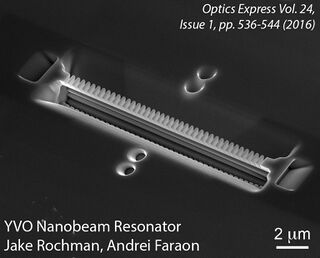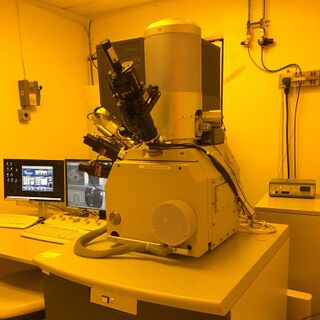Nova 600 NanoLab: SEM, Ga-FIB, GIS & Omniprobe: Difference between revisions
Jump to navigation
Jump to search
| (8 intermediate revisions by 4 users not shown) | |||
| Line 7: | Line 7: | ||
|RoomLocation = B233B Steele | |RoomLocation = B233B Steele | ||
|LabPhone = 626-395-1534 | |LabPhone = 626-395-1534 | ||
|PrimaryStaff = [[ | |PrimaryStaff = [[Alireza Ghaffari]] | ||
|StaffEmail = | |StaffEmail = alireza@caltech.edu | ||
|StaffPhone = 626-395- | |StaffPhone = 626-395-3984 | ||
|Manufacturer = FEI (now Thermo Fisher) | |Manufacturer = FEI (now Thermo Fisher) | ||
|Model = Nova 600 NanoLab | |Model = Nova 600 NanoLab | ||
|Techniques = SEM, Ga-FIB, Omniprobe,<br>Immersion Lens Imaging,<br>GIS, Cross-sectioning,<br>TEM Lamella Sample Prep | |Techniques = SEM, Ga-FIB, Omniprobe,<br>Immersion Lens Imaging,<br>GIS, Cross-sectioning,<br>TEM Lamella Sample Prep | ||
|RequestTraining = | |RequestTraining = alireza@caltech.edu | ||
|EmailList = kni-sem-fib | |EmailList = kni-sem-fib | ||
|EmailListName = SEM-FIB | |EmailListName = SEM-FIB | ||
| Line 35: | Line 35: | ||
== Resources == | == Resources == | ||
===== SOPs & Manuals & SDS ===== | ===== SOPs & Manuals & SDS ===== | ||
* [https://caltech.box.com/s/ | * [https://caltech.box.com/s/rpbtox8l31qi3kw3b014e3e8i4ctjpdy KNI Microscopy Policies] | ||
* [https://caltech.box.com/s/3v19boseiba88mcujrljctpafyz8f4sh SOP, Manuals and SDS] | * [https://caltech.box.com/s/3v19boseiba88mcujrljctpafyz8f4sh SOP, Manuals and SDS] | ||
* [https://caltech.box.com/s/ | * [https://caltech.box.com/s/a7rguo6eyf5aq5tpel3bsu2xsg8ko9an Nova NanoLab Operation Manual] | ||
* [https://caltech.box.com/s/j0t3w6i53jhfjcva8i4qvlatdh7t1tzw Gas Injection Systems – Deposition of Platinum (Technical Note)] | * [https://caltech.box.com/s/j0t3w6i53jhfjcva8i4qvlatdh7t1tzw Gas Injection Systems – Deposition of Platinum (Technical Note)] | ||
* [https://caltech.box.com/s/sm7q7teh5fo5hg3e6flkjbcbycmarrm3 Gas Injection Systems – Deposition of SiOx (Technical Note)] | * [https://caltech.box.com/s/sm7q7teh5fo5hg3e6flkjbcbycmarrm3 Gas Injection Systems – Deposition of SiOx (Technical Note)] | ||
| Line 51: | Line 48: | ||
* [https://youtu.be/UfF_ljwvepQ Getting Started] | [https://youtu.be/luC-5TgNPsQ Basic SEM Alignment] | * [https://youtu.be/UfF_ljwvepQ Getting Started] | [https://youtu.be/luC-5TgNPsQ Basic SEM Alignment] | ||
* Astigmatism Correction ([https://youtu.be/YeukVt1Fyi0 Details] | [https://youtu.be/WFfOi-rwlbA On Right-Angle Features] | [https://youtu.be/1syySgnTEqU Stigmator Alignment]) | * Astigmatism Correction ([https://youtu.be/YeukVt1Fyi0 Details] | [https://youtu.be/WFfOi-rwlbA On Right-Angle Features] | [https://youtu.be/1syySgnTEqU Stigmator Alignment]) | ||
* [https://youtu.be/R_RYbtumU20 Adjusting TLD Voltage to Capture SE vs. BSE Signal] | * [https://youtu.be/R_RYbtumU20 Adjusting TLD Voltage to Capture SE vs. BSE Signal] | ||
| Line 63: | Line 57: | ||
===== Presentations ===== | ===== Presentations ===== | ||
* SEM Essentials: Capabilities and Limitations of Scanning Electron Microscopy; and SEM Setup, Parameters and Theory for Successful Operations and Measurements | |||
**[https://caltech.box.com/s/eg20eqw7si5ka0bms251qurfwhys0hta Download .pptx Slides] | |||
* Scanning Electron Microscopy (SEM): Principles, Techniques & Applications | * Scanning Electron Microscopy (SEM): Principles, Techniques & Applications | ||
** [https://caltech.box.com/s/lulkj0pwm053akyya1shazg8wzgudq9f Pptx Slides] | [https://youtu.be/Zh21tp3aPEw YouTube Lecture] | ** [https://caltech.box.com/s/lulkj0pwm053akyya1shazg8wzgudq9f Pptx Slides] | [https://youtu.be/Zh21tp3aPEw YouTube Lecture] | ||
* Gallium Focused Ion Beam (Ga-FIB) Microscopy: Principles, Techniques & Applications | * Gallium Focused Ion Beam (Ga-FIB) Microscopy: Principles, Techniques & Applications | ||
** [https://caltech.box.com/s/f4k8jan85n5lf6f2tutjx4rkfzjq7y68 PPtx Slides] | [https://youtu.be/3eSzisbNcGo YouTube Lecture] | ** [https://caltech.box.com/s/f4k8jan85n5lf6f2tutjx4rkfzjq7y68 PPtx Slides] | [https://youtu.be/3eSzisbNcGo YouTube Lecture] | ||
===== Simulation Software ===== | ===== Simulation Software ===== | ||
| Line 112: | Line 107: | ||
<br> | <br> | ||
<br> | <br> | ||
Latest revision as of 22:35, 5 February 2025
|
Description
The Nova 600 is a "dual-beam" system that combines a field emission gun (FEG) scanning electron microscope (SEM) with a gallium focused ion beam (Ga-FIB). It can be used to capture high-quality images (clearly resolving sub-10 nm features) and perform site-specific etching and material deposition (creating sub-20 nm features). It is also equipped with an Omniprobe nanomanipulator, which can be used to lift out lamella samples that are prepared for use in a transmission electron microscope (TEM). See a full list of training and educational resources for this instrument below.
SEM Applications
- Ultra-High-Resolution Imaging (Immersion Mode aka UHR Mode)
- High-Resolution Imaging (Field-Free Mode aka Normal Mode)
- Secondary Electron (SE) imaging with an Everhart-Thornley Detector (ETD) & Through-the-Lens Detector (TLD)
- Backscattered Electron (BSE) imaging with a TLD
- Platinum deposition via Gas Injection System (GIS)
- Automated imaging with RunScript program & AutoScript language
Ga-FIB Applications
- Directly etch patterns into material
- Cutting & Imaging Cross-Sections
- TEM Lamella Sample Preparation using an Omniprobe for Liftout
- Platinum & SiOx deposition via GIS
- Enhanced etch with XeF2 via GIS
- Automated patterning with RunScript program & AutoScript language
Resources
SOPs & Manuals & SDS
- KNI Microscopy Policies
- SOP, Manuals and SDS
- Nova NanoLab Operation Manual
- Gas Injection Systems – Deposition of Platinum (Technical Note)
- Gas Injection Systems – Deposition of SiOx (Technical Note)
- Gas Injection Systems – Etching with IEE aka XeF2 Etch (Technical Note)
- Scripting – AutoScript Language Manual (year 2000 Technical Note: most complete)
- Scripting – RunScript Manual
Video Tutorials
- Getting Started | Basic SEM Alignment
- Astigmatism Correction (Details | On Right-Angle Features | Stigmator Alignment)
- Adjusting TLD Voltage to Capture SE vs. BSE Signal
Graphical Handouts
Presentations
- SEM Essentials: Capabilities and Limitations of Scanning Electron Microscopy; and SEM Setup, Parameters and Theory for Successful Operations and Measurements
- Scanning Electron Microscopy (SEM): Principles, Techniques & Applications
- Gallium Focused Ion Beam (Ga-FIB) Microscopy: Principles, Techniques & Applications
Simulation Software
- CASINO Electron Beam Simulation Software – simulate e-beam/specimen interactions
- The Stopping & Range of Ions in Matter (SRIM) – simulate i-beam/specimen interactions
Calibrate Measurements with NIST Standard
- The KNI has a NIST-traceable standard against which SEM and Ga-FIB measurements can be compared. See Slides 54-55 of the SEM Presentation for details. Ask staff for help finding and using the standard in the lab.
Sample Preparation
- Use the Carbon Evaporator to make non-conductive samples conductive by applying 2-10 nm of evaporated carbon.
- Use the O2/Ar Plasma Cleaner to remove hydrocarbons from the sample surface to avoid creating dark contamination spots on your features while imaging them.
Stubs for specimen mounting
- Stubs used for mounting specimens are considered a personal, consumable item in the KNI. There are some stubs at each Microscope which can be used by any KNI microscopy user. You can also buy your own stubs so that you can keep them clean and available to you. There are many stub geometries and configurations. If you chose to buy your own stubs, please show them to the staff microscopist prior to using them: some stubs including stubs with copper clips have large height differences and can only be used safely in specific operating conditions.
Guide to Choosing KNI SEMs & FIBs
Specifications
Manufacturer Specifications
- Nova 600 NanoLab Data Sheet (not all parameters apply to our instrument, see below for details specific to the KNI's Nova 600)
SEM Specifications
- Minimum Feature Size Resolved in Immersion Mode: ~5 nm
- Voltage Range: 0.2 to 30.0 kV
- Current Range: ~10 pA to 20 nA
- Apertures: 10 μm, 15 μm, 20 μm, 30 μm
- Eucentric Height: ~5.15 mm working distance (WD)
- Stage Range: ±80 mm X & Y travel, 12 mm Z travel, -12 to 58° tilt, 360° rotation
- ETD Grid Bias Range: -150 to 300 V
- TLD Bias Range: -100 to 150 V
- Ultimate Vacuum: 5e-7 mbar
Ga-FIB Specifications
- Minumum Probe Size Achieved: ~7 nm
- Minimum Feature Size Etched: ~25 nm
- Minimum Feature Size Resolved by Imaging: ~10 nm
- Voltage Range: 5 to 30 kV
- Current Range: 1 pA to 20 nA
- Eucentric Height: ~5.15 mm working distance (WD)
- Stage Tilt to be perpendicular to Ga-FIB: 52°
- ETD Grid Bias Range: -150 to 300 V
- TLD Bias Range: -100 to 150 V

